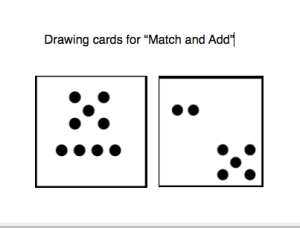 Number sense is an important thing for students to develop. Some do it naturally, but most do so as the result of activities and lessons that are designed to have students think about numbers and their relationships with each other.
Number sense is an important thing for students to develop. Some do it naturally, but most do so as the result of activities and lessons that are designed to have students think about numbers and their relationships with each other.
I recently had an email from a teacher asking how she might use dot cards to help the students in her grade 2/3 split class develop number sense, so this post is specifically to address that question of Amanda’s.
I use dot cards extensively in K and grade 1 classrooms, but they can be used for grade 2 and 3 students as well, especially if those students have not been exposed to many visual representations of numbers. If students are rather unfamiliar with the visuals, going back to the “basics” and working with them regularly for short periods of time is profitable. There are many ideas for such activities in the handout from my Dot Plate Workshop. (Here is a link for my other posts that refer to using dot cards.)
Here are a few ways to use the dot cards for grade 2/3 students:
Estimation: have the dot cards in a pile, a basket, or other way to easily access them. Have students draw three or more cards and then estimate the sum. It is important to have students discuss why they made the estimation that they did. It is also important to not force them to get really close to the actual sum. Rather, the skill is to practice the thinking about the numbers to get a reasonable sum. There are many ways students might do this: they might look for pairs of cards close to 10; they might decide that every card is either over or under 5 by a bit, and thus just add 5 for every card; they might realize that no card has more than 10 dots, so the answer cannot be more than the number of cards x 10; they might use a combination of methods to get as close to the answer as they can. Again, it is the process of thinking that is important here.
Mental Math: again, have the dot cards ready to be accessed, but also have some “decade cards” marked with 20, 30, 40, 50, 60, 70, 80. 90, 100 (and higher if you wish, depending on the ability of the children.) Have the students draw a dot card and a decade card, and subtract the dot card from the other number: e.g., if a student draws the 60 card and a 4 dot card, he would do the question 60 – 4 = 5. We have students practice subtracting in basic facts (including 10 – x) but often we do not have them practice the mental math of subtracting from other two-digit numbers. This is a great place to begin that practice.
Match and Add: place the dot cards face up. Have students scan the cards for two that have the same visual someplace on the card. For instance, a student may pick two different cards that each have “5-on-a dice” on them, and then add the two amounts (In the illustration, the student would be adding 9 + 7 but may see the strategy 5 + 5 + 4 + 2).
Once students are quite familiar with the dot card/dot plate visuals, it is fine to do the exercises with numerals cards.
Mathematically yours,
Carollee